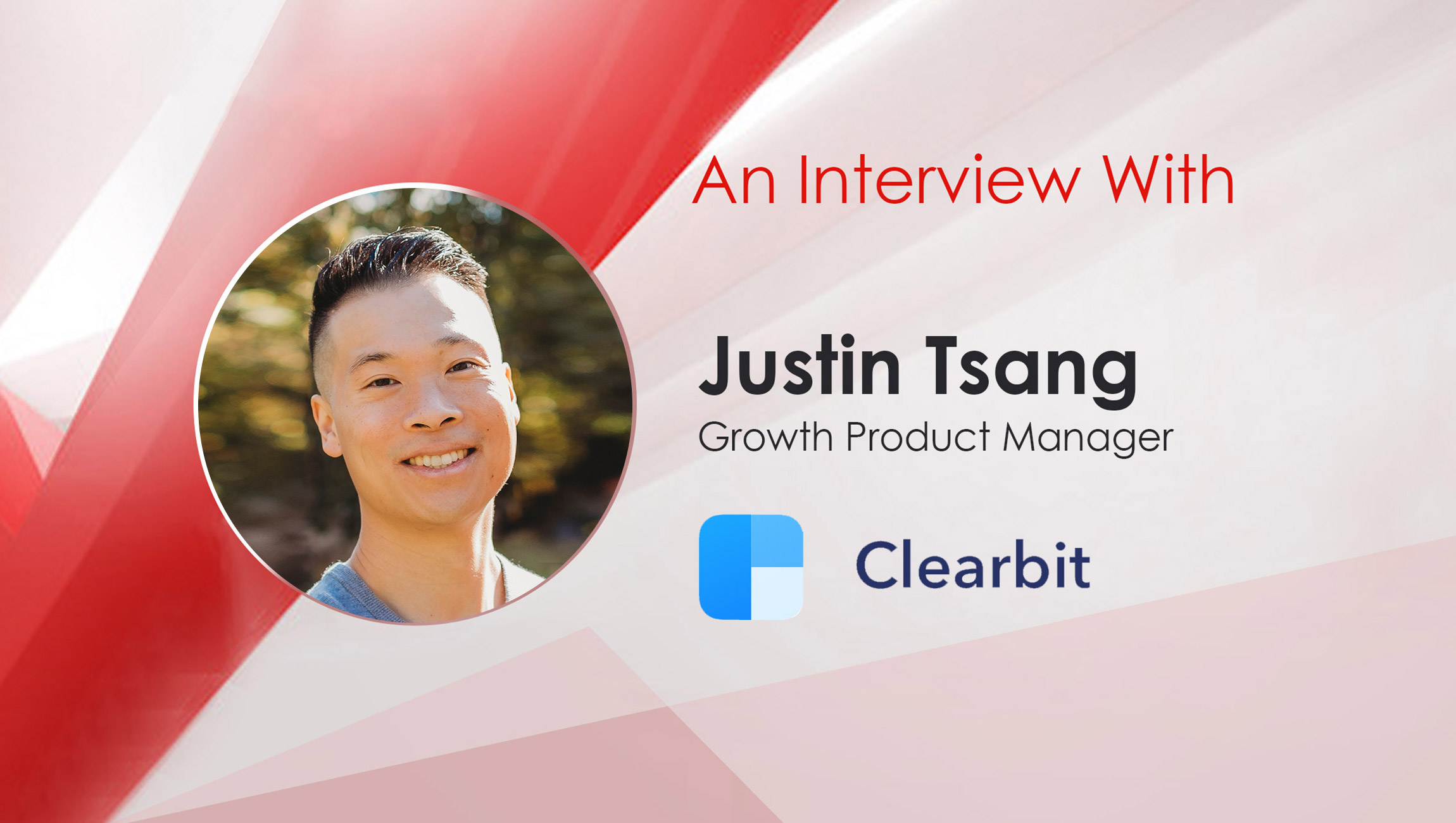Justin Tsang, Growth Product Manager at Clearbit chats about a few product marketing tips and tricks in this catch-up with MarTech Series;
________
Welcome to this MarTech Series chat, Justin, tell us about yourself and your role at Clearbit…
Thanks for having me! My name is Justin Tsang, and I’m a Growth Product Manager at Clearbit. My team and I have a very specific mandate: ship free tools and experiences that help revenue-driven marketers grow faster and more efficiently. A good example is our recent Product Hunt launch for the Weekly Visitor Report 2.0. Once installed, you get a free weekly dashboard of de-anonymized companies visiting your website and showing intent.
It’s a meaningful focus given the current business environment, where more and more B2B companies are staring down increased competition and smaller budgets.
Prior to making the jump to PM, I spent 15 years doing marketing, growth, and customer success for various B2B SaaS companies, focusing on acquisition, retention, and monetization.
What do you feel product marketers in B2B today need to be focusing on to drive their business goals?
Given the current economic environment, which is leading to tighter budgets and more focused planning, I think product marketers need to shift their mindset and messaging from “growth-at-all-costs” to “growing efficiently.” At Clearbit, and with our B2B customers, we’re seeing that result in a focus on things like:
- Positioning ROI in Terms of Efficiency: For B2B product marketing teams who are selling into companies facing tighter budgets, reframing their solution value & ROI in terms of shorter-term, bottom-line impact is key. Often, this requires a slightly different lens on key value props and personas.
- Aggressive Differentiation: A key to weathering a downturn is heightened awareness of customer needs and competitive offerings. With fewer customers looking to buy today, you want to make sure you show up with differentiated solutions and benefits that speak to specific, pressing needs. This not only gives teams a reason to choose you over your competitors, but positions you as a company that’s able and ready to help them regardless of market environment.
- Put Market Insight into Action: One of the trickiest things for product marketers is ensuring that the insights, strategy, and enablement that they create are actually leveraged by go-to-market teams in an effective and timely fashion. In a good market, this can be just an annoyance. In a bad market, being off the mark can be crippling for the business. Product marketers should be working closer than ever with their GTM counterparts to align positioning, messaging, and sales execution.
Marketing Technology News: MarTech Interview With Tal Jacobson, General Manager at CodeFuel
How in your view has product marketing changed over the years? And how do you feel the role is set to evolve further in the future?
Product marketing has always been a broad department in B2B organizations, and one that encompasses different functions, depending on the company. Over the past few years, I think we’ve seen that scope expand even more, with product marketing sometimes including everything from traditional functions like positioning, messaging and sales enablement, to newer areas such as Product-Led Growth motions.
Looking ahead, we’re seeing a couple of trends poised to shape the role and focus of Product Marketing in the near future.
The first is a focus on the power and potential of the Ideal Customer Profile or “ICP.” We’re seeing ICP gain momentum as a key element of companies’ go-to-market strategy, and one that often starts in and centers around the Product Marketing function. As ICP-driven strategies evolve, I think we’ll see Product Marketing in the driver’s seat of that go-to-market evolution.
The second is the emergence of more integrated and automated go-to-market technologies that allow product marketing to effectively “operationalize” their strategy across systems and processes. One example we’re already seeing is Product Marketing working with Operations teams to turn their ICP strategy into reality by applying their specific ICP definition across the customer journey, from ad targeting to the website experience to sales activity prioritization. As the tools to orchestrate and automate the customer journey mature, we’ll see this accelerate even more.
Taken together, these two trends are bringing product marketing’s strategy, positioning, and messaging closer to the actual go-to-market operations of the company. And while product marketing has historically worked through and with other team members in sales, marketing and operations, they’ll increasingly be turning to automated systems and coordinated go-to-market applications to bring their strategies to market.
Closer home at Clearbit, we’d love to know more about your core product and growth marketing initiatives and how that works/what martech is used to drive efforts?
Clearbit is a data activation platform that helps companies discover, engage, and convert their most valuable customers — all from one flexible go-to-market foundation. With Clearbit, teams can find new prospects, prioritize and convert their best opportunities, and understand the ROI of their go-to-market efforts at each stage of the funnel.
We use a variety of marketing and growth initiatives to create demand for our platform, and work hand-in-hand with our XDRs and AEs to convert that demand. For our mix, we employ a combination of standard, but highly performant initiatives (like events, content, email, CRO, and paid), corporate and brand marketing (via media and analyst relations), and what I focus on, which is free tools and experiences.
The cool thing is that all of these initiatives work together. With each one optimized for a different level of awareness and intent, we’re able to provide our customers different, relevant offers as they progress from becoming problem aware and low intent, to most aware and high intent.
And because we work so closely with Sales, our marketing is able to drive both inbound demand, and create warm outbound opportunities for our BDR team.
In terms of the martech stack that makes these initiatives possible, we primarily use:
- Segment, Tray.io, and Census to manage, transform, and integrate our marketing data
- Mode and Google Analytics to analyze and report on performance
- Salesforce, Madkudu, and LeanData to score and route the demand we convert
- Zapier and Customer.io to automate our marketing engagement
- Contentful and Livestorm to manage and host our content and events
- Mutiny to run personalization experiments on our website
- And of course, Clearbit, to power or enhance every tool I mention above!
Clearbit recently announced a few enhancements, we’d love to hear about these…how does it enable end users?
Earlier this year we rolled out our unified platform: the Data Activation Platform. With its launch, our customers are now able to go to one place to activate their Ideal Customer Profiles. This means one place to achieve efficient revenue growth by being able to systematically identify new ideal customers, convert high-intent prospects, and prioritize the best opportunities.
It’s super exciting because our customers can now log into Clearbit and improve the accuracy and efficiency of their marketing, sales, and operations from top to bottom. For example, they can create precise B2B Facebook advertising audiences on Monday, enrich their CRM and MAP records on Tuesday, personalize their website and chatbots on Wednesday, set-up sales alerts for target accounts on Thursday, and de-anonymize high-intent prospects to route to Sales on Friday.
If your goal is to grow and win despite increasing channel competition and rising acquisition costs, the Data Activation Platform is your best bet.
Marketing Technology News: When Your Customers Have Customers: How B2B Marketers Can Support Small Businesses
For marketers who use tools like this to better understand visitor traffic, what best practices would you share with them to help ensure better optimization of tool-data-output?
If you want to get the most out of your visitor identification solution, it’s important to keep the following three things in mind:
- Ideal Customer Profile (ICP): Before jumping to the how or what, you need to be crystal clear on the who. This will get you started on the right foot by helping you choose the right visitor identification solution. How? By being clear on your ICP, and knowing what firmographic attributes define your ICP, you can vet different solutions against their abilities to match against those attributes. For example, if your ICP is B2B SaaS in the North America, you’ll want to make sure you choose a tool that has high accuracy for de-anonymizing companies that are in B2B, have a SaaS business model, with HQs in North America.
- Use Case: There are many different visitor identification use cases. At Clearbit, our customers use our platform to personalize their website, chatbot, and scheduler experiences; create sales alerts for target accounts; generate audiences for ad retargeting; and a personal favorite of mine: execute high-intent outbound sales. It’s important that you’re clear on what use case makes the most sense for your business, because again, this has implications on what visitor identification solution you choose. Different tools will have strengths and capabilities that lend themselves better to different use cases – so do your research!
- Customer Journey: It doesn’t stop once visitors are de-anonymized. It’s just as important to architect the journey post-identification. Regardless if you’re personalizing your website or outbounding high-intent leads, spend the time to work with the appropriate teams to create the self-serve and sales-assisted next steps for your newly identified prospects. This is how you’ll get the most bang for your buck. For example, if you’re personalizing your homepage demo CTA for a specific vertical, ensure that you have a vertical-tailored sales sequence to maximize the conversion of hand raise to meeting held.
Some last thoughts, takeaways, before we wrap up!
Marketing teams are feeling a lot of pressure right now to deliver real results. This means revenue, not just top-of-funnel metrics. And that’s getting harder, because budgets are tighter, costs are going up, and channels are just more competitive.
At Clearbit, we’re thinking a lot about how to build cost-effective, scalable marketing strategies that drive revenue — not just leads or MQLs. And we think a big part of that is being able to activate your ICP. This means being able to systematically identify, convert, and prioritize your best customers throughout the buying process.
So whether it’s product marketing, visitor identification tools, or a platform like Clearbit that folds visitor identification in as a capability to help you discover, engage, and convert your ICP, now’s the time for marketers to be making the right investments for growing efficiently during the tricky months that are to come.

Clearbit’s Data Activation Platform gives B2B marketing teams a complete view of their market, prospects, and customers, and helps them reach and engage target audiences, build personalized buyer journeys, and act instantly on intent signals across the customer lifecycle.
From one easy-to-use interface, marketers can enhance their CRM, CDP, and marketing automation data with Clearbit’s firmographic, technographic, and website intent data to create precise, real-time audiences that automatically reflect their market (e.g., job change, company funding) and their funnel (e.g., lead qualified, account closed). They can then activate their ideal customer profile across all of their go-to-market motions.
Justin Tsang is Growth Product Manager at Clearbit, where he’s focused on creating free products that enable revenue-driven marketers to experience the power of Clearbit’s technology. Justin has 15 years of marketing, growth, and customer success experience in B2B SaaS, with expertise in acquisition, retention, and monetization.
Missed The Latest Episode of The SalesStar Podcast? Have a quick listen here!
Episode 131: Product Management Tips and Best Practices with Kimen Warner, VP of Product Management at Drift
Episode 130: Digital Marketing and Ad Best Practices with John Piccone, Regional President, U.S, Adform
Episode 129: Regional Sales Development Best Practices with Abdul Javed, VP of Sales for APAC at Clari











